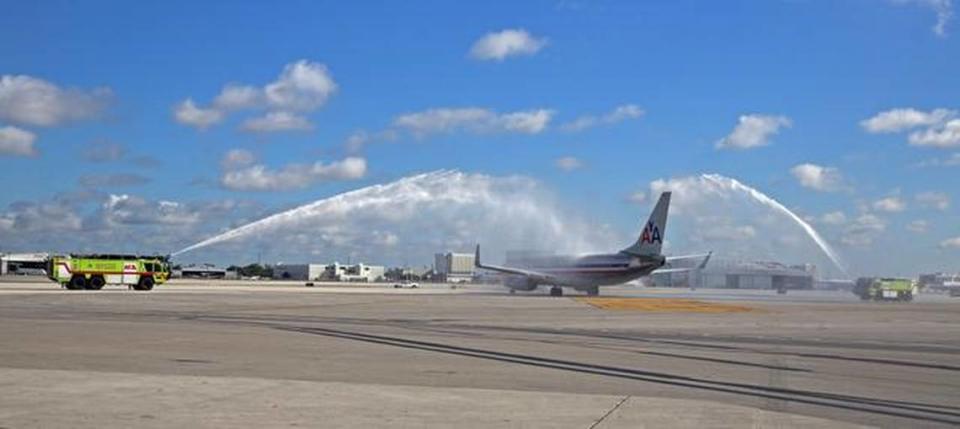American Airlines reduces service to Haiti, cancels Miami-Cap-Haïtien route
When American Airlines resumes service to Haiti on Tuesday, nearly four months after the borders were shut due to the coronavirus, there will be only one daily flight into Port-au-Prince’s Toussaint Louverture International Airport, and the country’s second largest city will not be on the schedule.
The first major commercial airline to land in Cap-Haïtien in 2014 after more than a decade due to a damaged runway, the Miami-based carrier told the Miami Herald that it is canceling service to the city.
“Canceling the flight to Cap-Haïtien was very painful but a necessary decision given the current economic circumstances as a result of the pandemic,” said Martha Pantin, a spokeswoman with American. “We have had to make difficult decisions that affect many destinations around the world that we serve.”
The only other city in the hemisphere that American is suspending service to is Brasilia in Brazil.
American’s decision leaves Cap-Haïtien and northern Haiti with no major U.S. airlines. Last year, Spirit Airlines suspended service from Fort Lauderdale, citing unrest and operational issues. The carrier returned to Port-au-Prince on Wednesday out of Fort Lauderdale, a day after Haiti reopened its borders.

“Unfortunately, AA decided to suspend the flight due to financial issues related to COVID-19 pandemic. We are currently working with them to get the flight back as soon as possible,” Haiti Tourism Minister Myriam Jean said. “In the meantime, we are working with local airlines to lower their costs during the summer season.”
Florida’s COVID-19 surge leads to tighter restrictions for some Caribbean visitors
Wednesday’s resumption of service by Spirit Airlines and JetBlue out of Fort Lauderdale and New York have been welcomed by Haitians, some of whom had been stuck in the United States since Haiti shut down its air and land borders on March 20 after confirming its first two cases of COVID-19 on March 19.
But while travelers on Wednesday were able to return home without proving they are COVID-free, the government has done an about face over requiring tests and now says a negative COVID-19 PCR test from a laboratory with results given within 72 hours of travel will be required for entry. Visitors will also need to fill out a health questionnaire.
With no regular service into Cap-Haïtien out of the U.S., which is home to Haiti’s largest diaspora, many of whom are from the northern region of the country, Haitians will have to go back to how life was before 2014: fly to Port-au-Prince and from there either pay for another flight aboard a small plane to Cap-Haïtien or travel five to six hours by road.
For years, a lopsided runway — one part was higher than the other — had prevented Haitians from getting full use of the airport, which was damaged after the country’s defacto government in 1992 fixed it. The damage meant that large aircraft could not land, and in 2004, during a bloody coup that forced the departure of then President Jean-Bertrand Aristide into exile, the airport was burned down.
In 2009, then president René Préval decided to defy the U.S. and others in the international community, and borrowed $33 million from Venezuela’s Economic and Social Development Bank to renovate the runway and rebuild the airport’s facilities.
Three years later, a U.S. government 757 carrying then U.S. Secretary of State Hillary Clinton landed just behind her husband, former President and U.N. Special Envoy to Haiti Bill Clinton, on the newly asphalted 7,500-foot runway to inaugurate the post-earthquake Caracol Industrial Park. The tar was still wet during the landing, which not only marked the first time in more than a decade a large aircraft had landed in Cap-Haïtien but also the first time the Clintons visited Haiti together since their honeymoon in the country 37 years earlier.
Former President Michel Martelly later changed the airport’s name in honor of Venezuelan leader Hugo Chávez and led a group of high-profile Haitian Americans on American Airlines first inaugural daily nonstop flight out of Miami to the city.
American’s vice president for Mexico, the Caribbean and Latin America at the time, Art Torno, described the decision to expand service as “a destination we’ve had our sights on for a very long time.”
But in the years since, Haiti’s instability, violent unrest and lockdowns as a result of anti-government protests have posed challenges for the carrier and for travelers. The destination also has not been as profitable as American had anticipated.
Two weeks before Haiti’s March 20 shutdown over the COVID-19 pandemic, the U.S. State Department raised its travel warning for Haiti to Level 4 — Do Not Travel — citing a rise in armed robberies, carjackings and other violent crimes, including kidnappings.
The travel warning for Haiti replaced a Level 3, “reconsider travel,” advisory that was issued on June 11, 2019.
American Airlines’ reduced service to Haiti gives Haitians few options when it comes to international travel.
In early January, Delta Airlines operated its last flight between Atlanta and Port-au-Prince, citing low demand.
“This is a painful decision,” Pantin of American Airlines said. “We’ve been in Haiti many years. We appreciate the support our customers have given us.”

